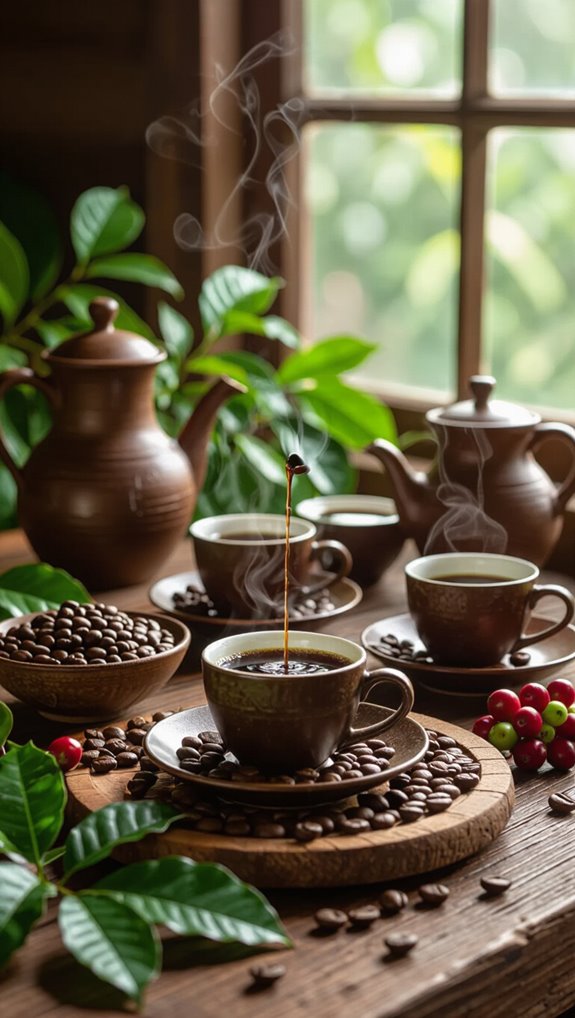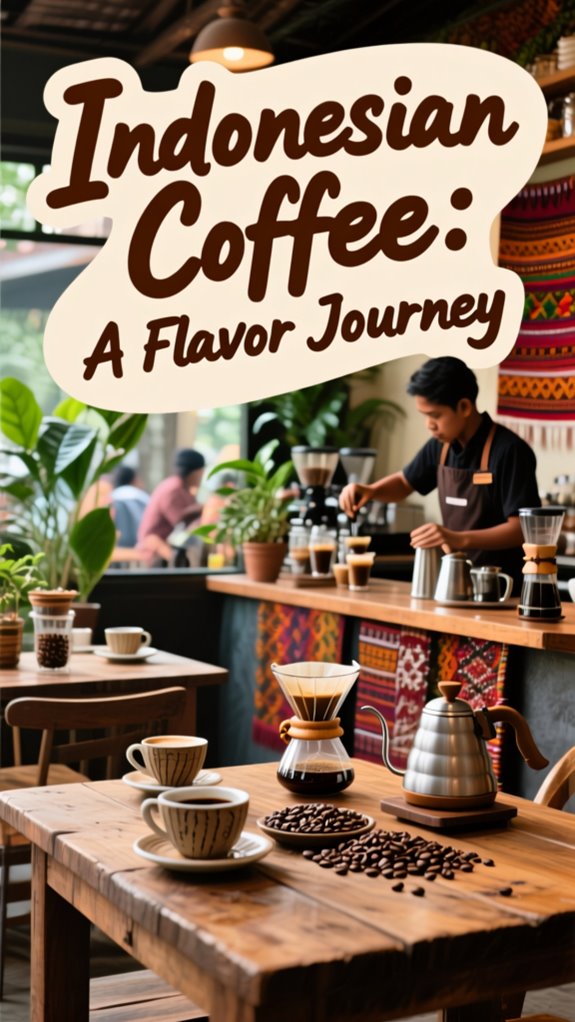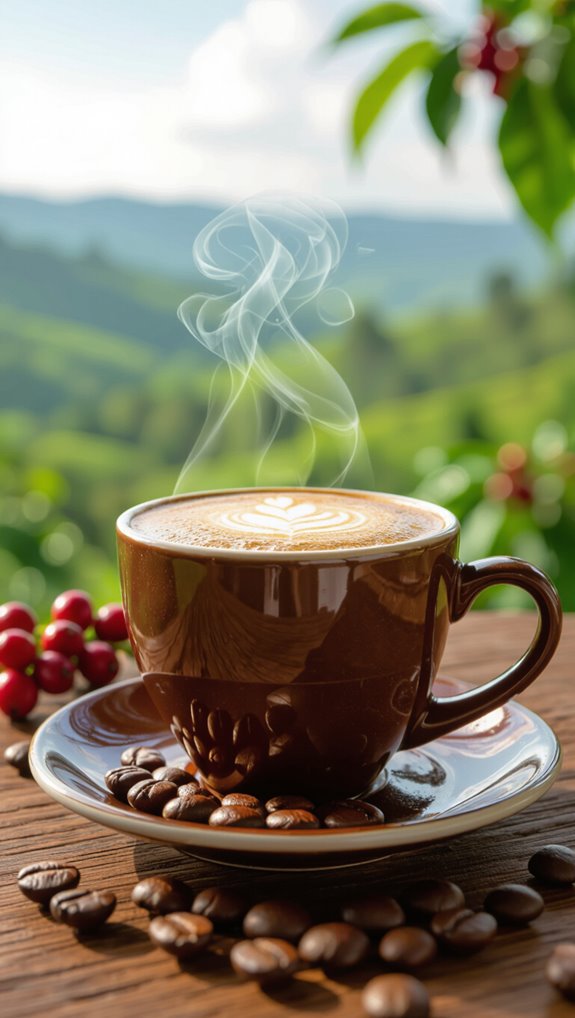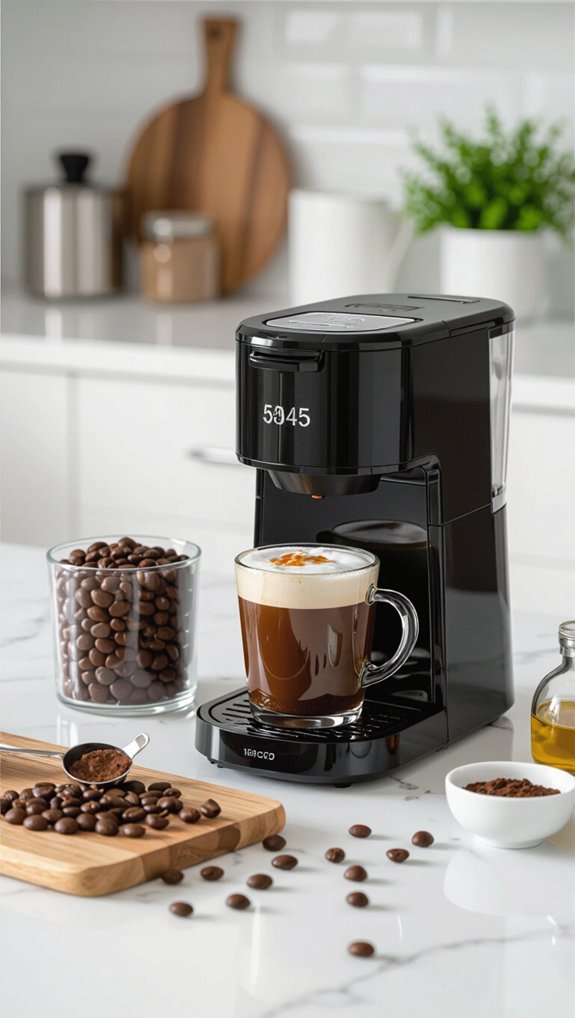Ever wondered why Indonesian coffee tastes so different from other beans? If you’ve been searching for a brew that goes beyond the usual bright, acidic profiles, you’re not alone. Indonesian coffee stands out with its distinctive earthy flavors, full body, and remarkably smooth finish—characteristics that coffee enthusiasts worldwide seek out but don’t always understand.
This guide breaks down everything you need to know about Indonesian coffee, from the famous growing regions like Sumatra and Java to the unique processing methods that create those signature flavor profiles. Whether you’re curious about what makes these beans special or looking for the best ways to brew them at home, we’ll walk you through the varieties, tasting notes, and expert brewing tips to help you get the most out of these exceptional beans.
Table of Contents
What makes Indonesian coffee so special
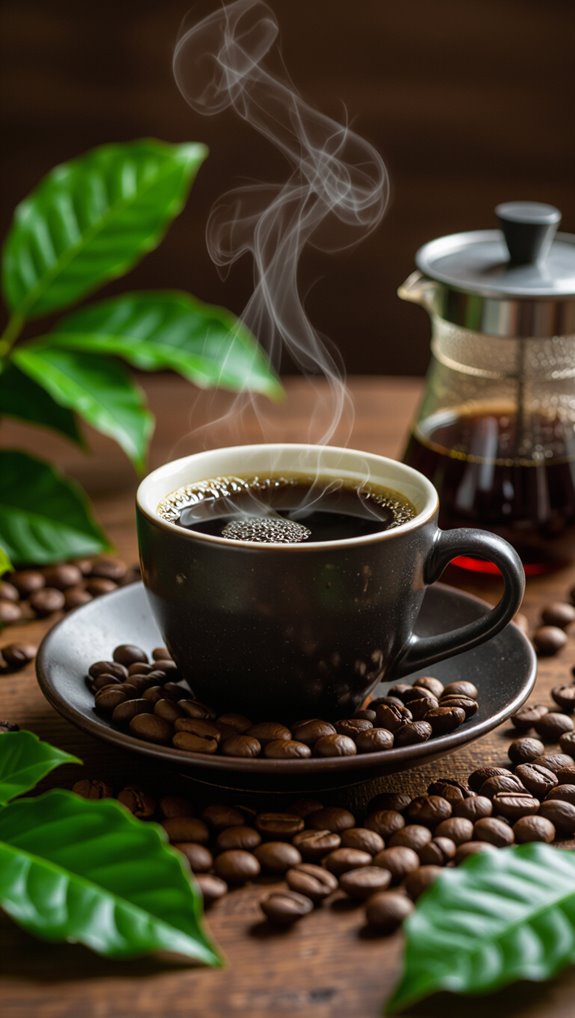
The liquid gold of Indonesia isn’t just coffee—it’s a sensory journey through volcanic landscapes and centuries-old cultivation traditions. High-altitude volcanic cultivation ensures that coffee beans develop slowly, absorbing complex nutrients that create extraordinary flavor profiles with remarkable depth.
From Sumatra’s earthy, low-acidity beans to Bali’s fruity notes, each region tells a different taste story.
The combination of traditional processing methods, nutrient-rich volcanic terrain, and slow cherry maturation results in coffees that are full-bodied, complex, and utterly distinctive.
It’s not just a drink—it’s a cultural experience in every sip.
The main Indonesian coffee growing regions
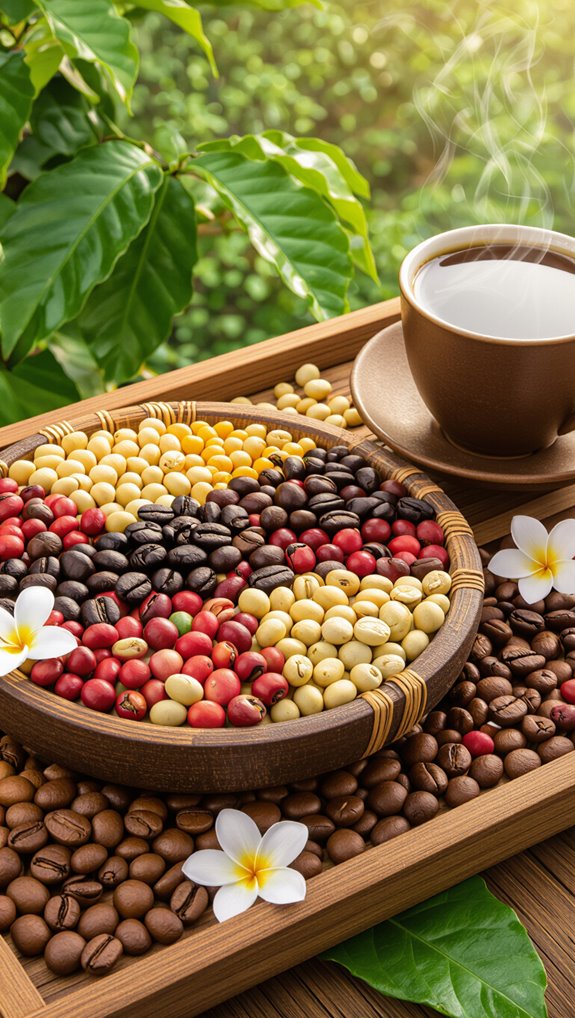
Indonesia’s coffee landscape is a vibrant tapestry of distinct growing regions, each offering unique flavors that reflect their volcanic terrains and microclimates. From Sumatra’s earthy Mandheling to Java’s smooth Arabica, these regions showcase incredible diversity. Mountainous interior regions create perfect microclimates that contribute to the distinctive characteristics of each coffee-producing area.
| Region | Key Characteristics | Flavor Profile |
|---|---|---|
| Sumatra | Volcanic soil, wet-hulled | Earthy, full-bodied |
| Sulawesi | High elevation | Complex, balanced |
| Papua | Remote, organic | Rare, untouched |
Each region brings something special to the table. Sumatra’s low-acid, syrupy coffees contrast with Bali’s bright, citrusy beans. Papua’s limited production makes its organic coffees particularly prized, while Java’s historic estates continue to produce exceptional blends that coffee lovers worldwide cherish.
What does Indonesian coffee taste like

A liquid velvet symphony of flavor, Indonesian coffee captivates coffee lovers with its rich, complex taste profile that’s as diverse as the archipelago’s volcanic landscapes. Historical cultivation origins reveal how Dutch colonists introduced coffee in the 1600s, establishing a legacy of exceptional coffee production. Characterized by low acidity and full body, these coffees offer earthy, chocolate, and spicy notes that dance across your palate.
Regional variations shine through—Sumatran beans deliver intense earthiness, while Balinese coffees surprise with light, fruity undertones. The unique wet-hulling process imparts distinctive rustic flavors like tobacco and leather, creating a taste experience that’s unmistakably Indonesian. Dark roasting amplifies these remarkable characteristics, transforming each sip into a sensory journey.
The unique wet hulling processing method
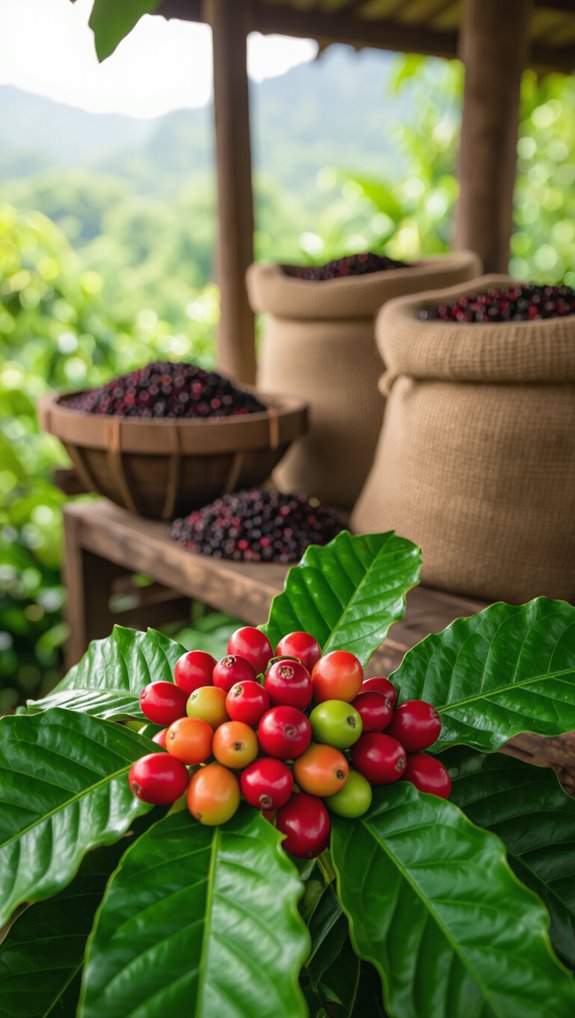
Diving deep into Indonesian coffee’s heart, wet hulling (or *Giling Basah*) emerges as a processing method that sets the archipelago’s beans apart from global competitors. This unique technique involves removing coffee parchment at higher moisture levels, creating beans with a distinctive dark, opal-green color and rustic appearance.
Developed in Indonesia’s humid climate, wet hulling allows farmers to process coffee quickly, reducing risks of spoilage and economic loss. The method produces coffee with a full body, thick syrupy mouthfeel, and rich earthy flavors that distinguish Indonesian beans from other global varieties.
How to brew Indonesian coffee at home
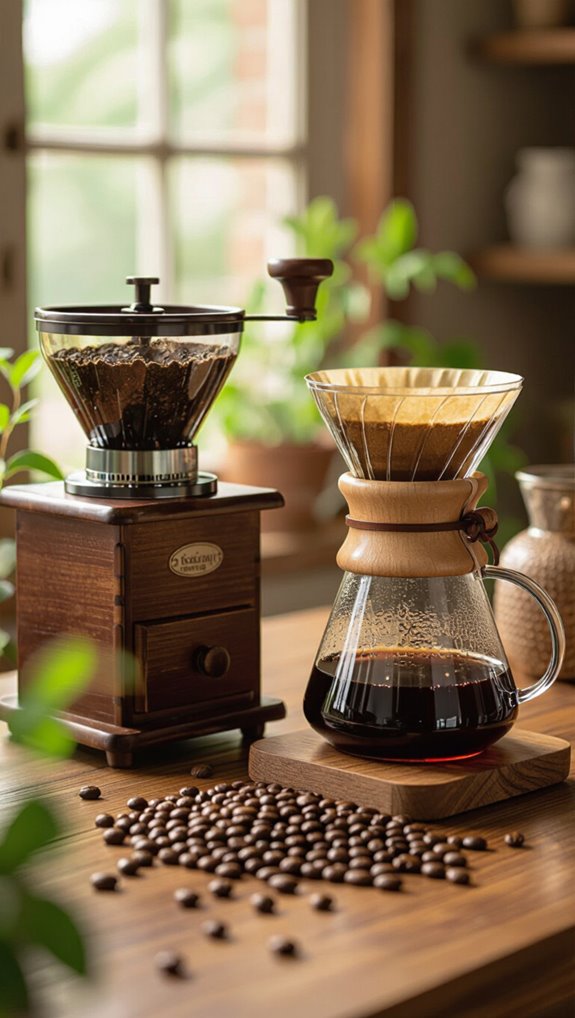
Let me walk you through brewing authentic Indonesian coffee right in your own kitchen, using traditional methods that capture the rich, earthy flavors of beans from regions like Sumatra and Java.
You’ll need just a few key ingredients like freshly roasted Indonesian coffee beans, the right equipment such as a French press or pour-over dripper, and some basic brewing techniques that highlight the coffee’s distinctive characteristics.
I’ll show you how to select your beans, choose the perfect brewing method, and create a cup that transports you to the lush coffee plantations of Indonesia.
Ingredients
Brewing authentic Indonesian coffee at home requires comprehension key ingredients that transform humble beans into a rich, aromatic experience. I’ll guide you through selecting the perfect components, focusing on high-quality Indonesian varieties like Java and Sumatra.
| Ingredient | Recommended Choice |
|---|---|
| Coffee Beans | Dark roasted Indonesian varieties |
| Water | Filtered, 90-95°C |
| Grind | Coarse to fine, depending on method |
My top tip? Always use freshly ground beans and experiment with traditional brewing styles like Kopi Tubruk. The right ingredients make all the difference between an average cup and a truly exceptional Indonesian coffee experience.
Equipment
With the aromatic world of Indonesian coffee beckoning, selecting the right equipment transforms home brewing from mundane to magnificent. Your journey starts with comprehension key tools:
- Brewing Devices: From French press for rich Sumatran styles to V60 for delicate flavor extraction, choose based on coffee profile.
- Grinders: Opt for burr grinders ensuring consistent particle size, critical for authentic Indonesian brew quality.
- Temperature Control: Use gooseneck kettles and precise water temperatures (90-96°C) to unlock complex flavor nuances.
Simple, thoughtful equipment elevates your Indonesian coffee experience, turning each cup into a sensory exploration of archipelago craftsmanship.
Instructions
Mastering the art of brewing Indonesian coffee at home transforms an ordinary morning into a sensory journey through the archipelago’s rich coffee culture. I’ll guide you through selecting the perfect beans and brewing method to capture Indonesia’s unique flavors.
| Brewing Method | Grind Size | Water Temp | Steep Time |
|---|---|---|---|
| Kopi Tubruk | Coarse/Fine | Boiling | 3-5 mins |
| French Press | Coarse | 200°F | 4 mins |
| Pour Over | Medium | 94°C | 2-3 mins |
| Espresso | Fine | 200°F | 25-30 secs |
Pro tip: Experiment with regional beans and roast levels to discover your perfect Indonesian coffee experience.
Popular Indonesian coffee varieties you should try
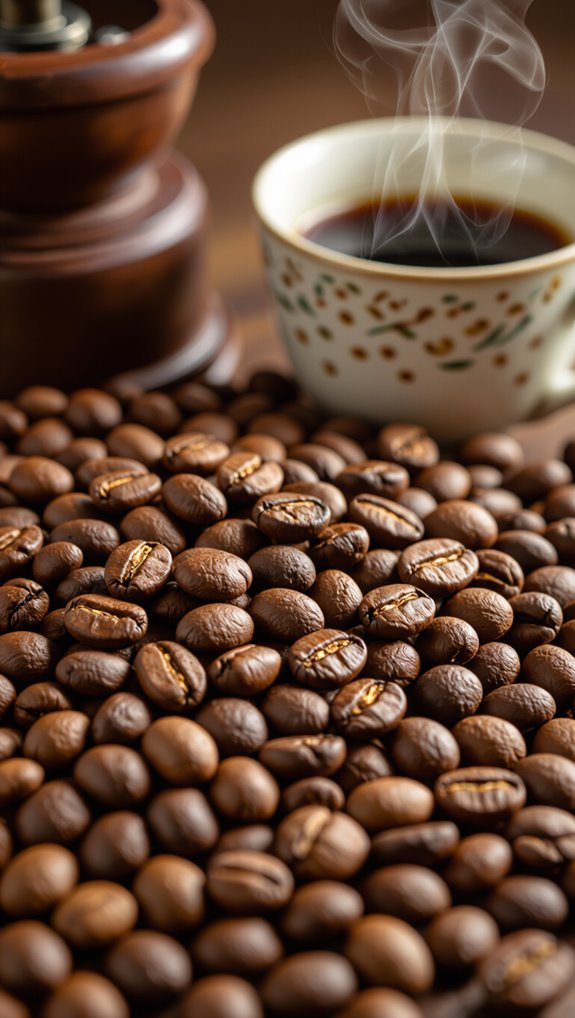
Indonesia boasts a rich tapestry of coffee varieties that’ll transport your taste buds to exotic landscapes with every sip.
If you’re looking to explore unique Indonesian coffees, consider these exceptional varieties:
- Toraja Coffee: A full-bodied treasure from Sulawesi’s highlands, offering deep, brooding flavors with subtle fruit undertones and a rich chocolate essence.
- Gayo Coffee: Hailing from Sumatra’s Aceh region, this coffee delivers a strong, earthy profile that’ll awaken your senses with its herbal complexity.
- Kopi Luwak: The world’s most infamous coffee, processed by civets and prized for its smooth, musky characteristics – though it comes with a hefty price tag.
Why Sumatra and Java coffees stand out
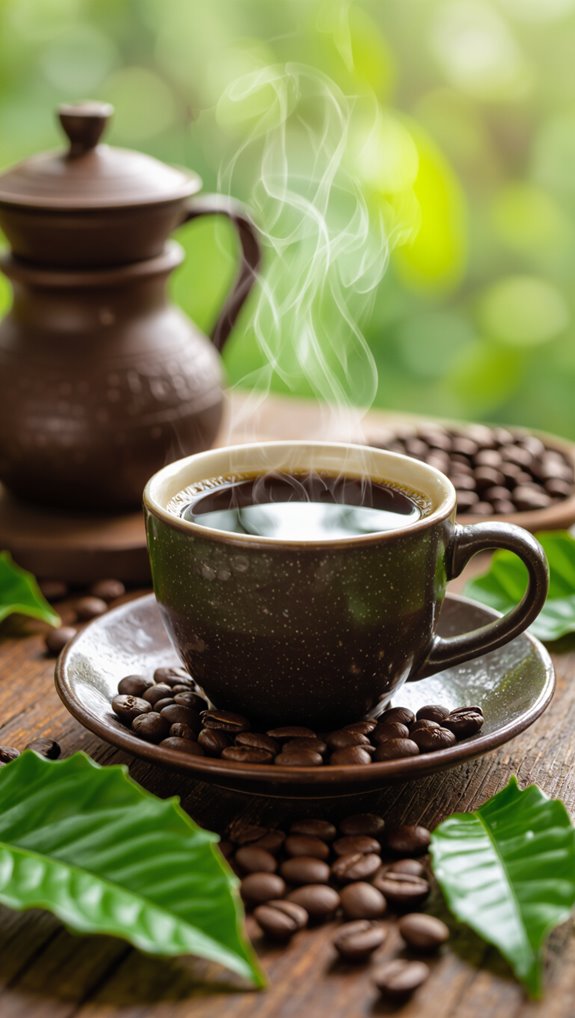
Because Sumatra and Java represent the beating heart of Indonesia’s coffee heritage, their unique terroirs and processing methods set them apart in the global coffee landscape. Java’s washed method delivers a clean, sweet profile with chocolate and fruit notes, while Sumatra’s wet-hulling creates an earthy, complex cup with intense herbal and spicy undertones.
These regions aren’t just producing coffee; they’re crafting liquid stories of tradition. Java’s centuries-old estates and Sumatra’s volcanic soils contribute distinctive characteristics that make each sip a journey through Indonesia’s rich coffee culture, offering coffee lovers an unparalleled sensory experience.
Best ways to buy authentic Indonesian coffee
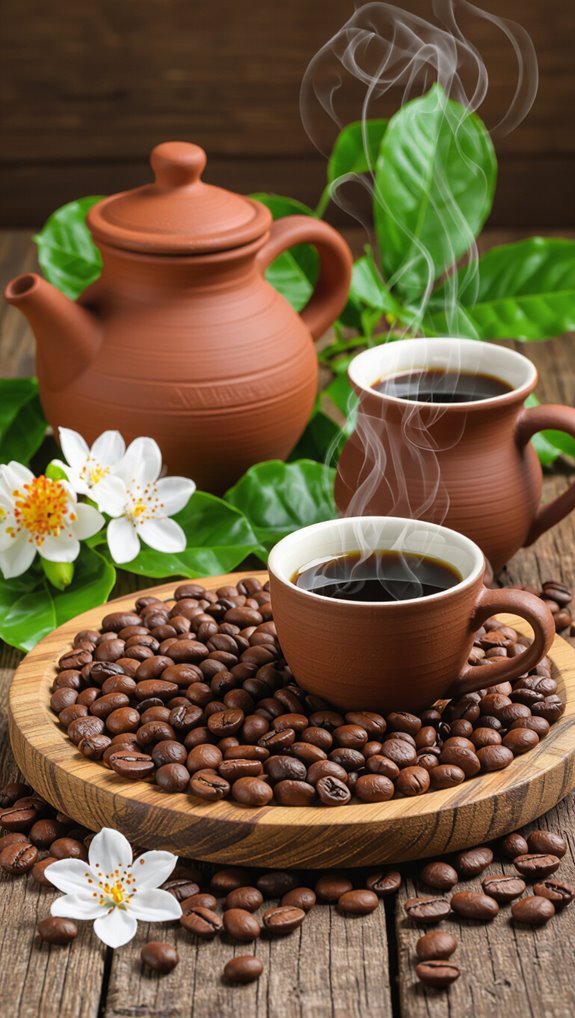
Discovering authentic Indonesian coffee requires a strategic approach that goes beyond casual browsing.
I recommend three key methods to ensure you’re getting the real deal:
- Shop directly from specialty online platforms like Kopi Kultur and Anomali Coffee, which source beans with transparent origins.
- Visit local Indonesian coffee markets or plantations when possible, guaranteeing freshness and supporting local farmers.
- Choose roasters who provide detailed information about bean traceability, processing methods, and ethical sourcing.
Indonesian coffee culture and drinking traditions
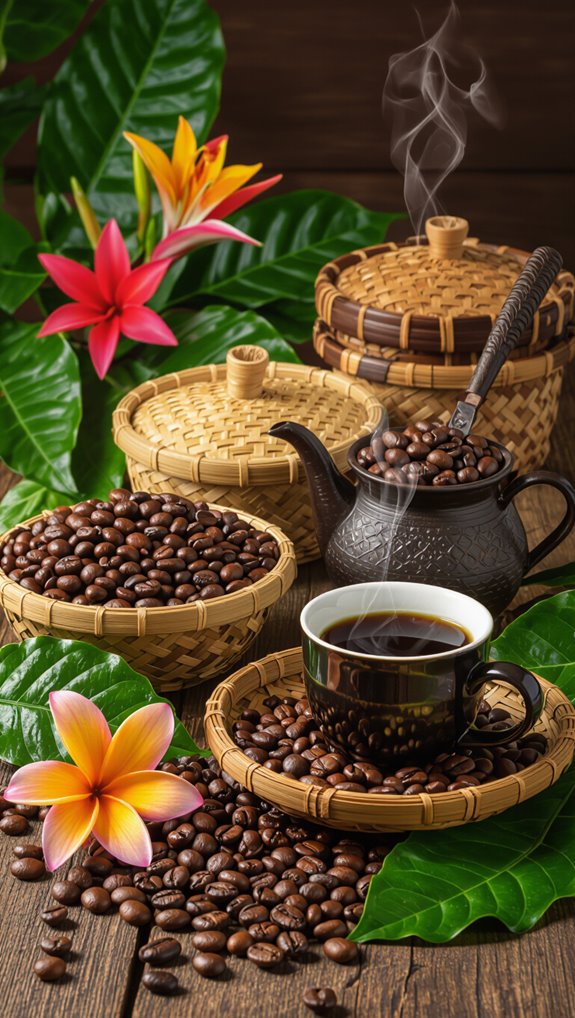
Deeply woven into the social fabric of Indonesian life, coffee represents far more than just a beverage—it’s a powerful cultural ritual that connects people, transcends generations, and tells the story of community and hospitality.
Coffee gatherings, known as “ngopi”, are sacred social experiences where friends and families bond over steaming cups.
Traditional brewing methods like Tubruk, where coffee grounds steep directly in hot water, reflect the intimate relationship Indonesians have with their coffee.
From traditional ceremonies to everyday interactions, coffee serves as a symbol of warmth, welcome, and shared connection, embodying the heart of Indonesian social culture.
Pairing Indonesian coffee with food and desserts
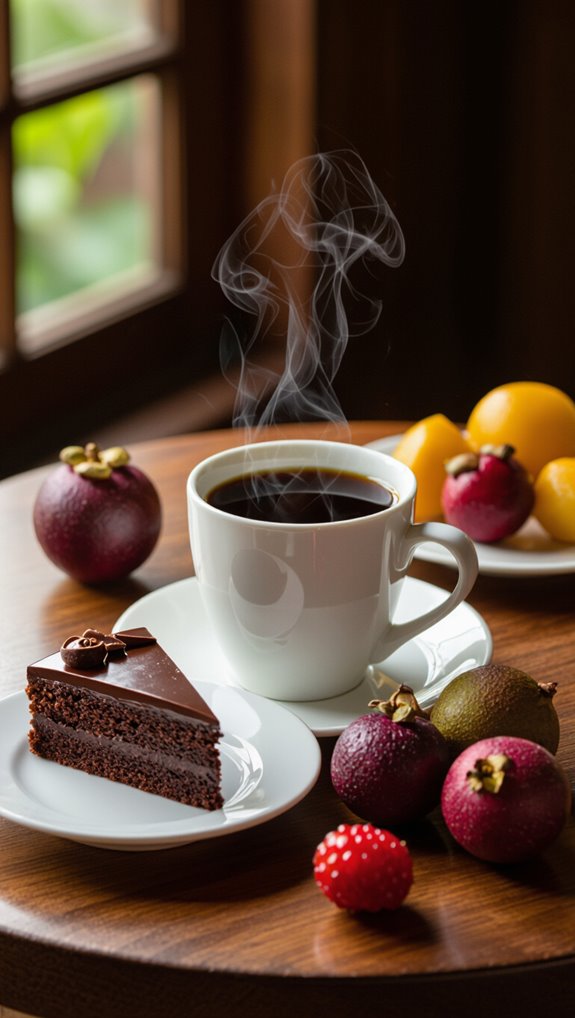
Indonesian coffee isn’t just a beverage—it’s a culinary adventure waiting to be explored through strategic food pairings that elevate both the coffee and the dish. I’ve discovered three incredible ways to transform your coffee experience:
- Contrast flavor profiles by matching earthy Indonesian coffee with sweet desserts like cheesecake or dark chocolate.
- Balance textures by pairing robust dark roasts with rich, creamy dishes.
- Complement regional cuisines by selecting coffee that enhances traditional Javanese or Balinese treats.
From breakfast to dinner, Indonesian coffee offers a versatile taste journey that’ll surprise and delight your palate.
Frequently Asked Questions
Is Indonesian Coffee Stronger or More Caffeinated Than Other Coffees?
Yes, Indonesian coffee can be stronger and more caffeinated, especially Robusta varieties. My Robusta blends often pack nearly double the caffeine of Arabica, reaching up to 159 mg per cup, compared to typical global coffee standards.
How Does the Price of Indonesian Coffee Compare to Other Origins?
Indonesian coffee prices vary widely. My specialty Sumatran arabica can command premium rates, while robusta remains more affordable. We’re competitive globally, especially for unique origins, though Brazil and Vietnam’s large-scale production often keep their prices lower.
Can I Find Indonesian Coffee in Local Grocery Stores?
Yes, you’ll find Indonesian coffee in larger grocery stores, especially those with international or gourmet sections. Look for Sumatra or Java blends from brands like Starbucks Reserve, though selection can be limited depending on your region.
Are There Organic or Fair Trade Indonesian Coffee Options?
Yes, you’ll find plenty of organic and fair trade Indonesian coffee options! Brands like PT Excelso offer certified coffees from regions such as Sumatra and Flores, ensuring ethical sourcing and supporting local farmers while delivering exceptional quality.
What Health Benefits Does Indonesian Coffee Offer?
I’ve discovered Indonesian coffee offers incredible health perks, including heart protection, blood sugar regulation, and powerful antioxidants. It can boost mental alertness, potentially reduce inflammation, and may even help prevent certain diseases through its rich bioactive compounds.
In Conclusion
Indonesian coffee is a journey of flavor, tradition, and passion that every coffee lover should experience. From the rich, earthy Sumatran beans to the smooth Javanese brew, each region tells a unique story through its coffee. If you’ve been wondering what makes Indonesian coffee so special, it’s this incredible diversity—volcanic soil, unique processing methods, and centuries of cultivation expertise combine to create some of the world’s most distinctive coffee profiles.
Whether you’re brewing at home or exploring local cafés, these beans offer a sensory adventure that connects you to Indonesia’s vibrant coffee culture. To truly unlock the full potential of these exceptional beans, having the right coffee machine makes all the difference. Check out our coffee machine reviews to find smart, well-reviewed options that will help you extract every nuanced flavor from your Indonesian beans.
Dive in, and let your taste buds explore this incredible coffee landscape—your perfect cup of Indonesian coffee is waiting to be discovered.

